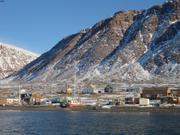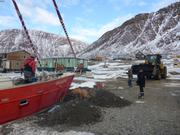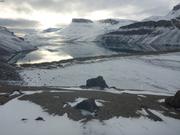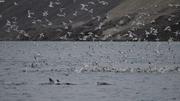Grise Fiord
Here we are alone again, just the family for the last week of the summer cruise. It's getting late in the season and the weather encourages us to explore the sheltered fjords. The first one east of Grise Fiord, the longest in the region (50km), is Starnes Fiord which I visited only once in spring to measure the thickness of the sea ice. This time, we discover its deep waters and its shallows.
We are surrounded with hundreds of harp seals, fulmar petrels, kittiwakes, herring gulls... all of them are stuffing themselves with small polar cods before migrating south when the sea will start to freeze early October. Foxes stealthily take advantage of the remains of the feast they find along the shore.
The seabed is rich, the water becomes clearer in this season, colder too! But above all, quite far from the suggested sites, we find some of the best coralline samples of the entire summer. As a result, centuries of data on the waters and the sea ice of this fjord. During the last dives, I do a few quadrats too, for the Arctic Kelp project.
On 19 September, the weather is good, the swell is weak, the tide is very high at 1 p.m., everything is in order to haul out Vagabond on the beach of Grise Fiord. At same place as 8 years ago, Raymond has prepared a real tailor-made port, the operation is simple and fast.
In ten days, we will leave our ship here for the winter and fly to France, which we do not yet know at the covid time. Nunavut, which we have not left since before the pandemic, has been spared until now. If conditions allow, we will come back to Vagabond in spring 2021, for the next scientific cruise.




